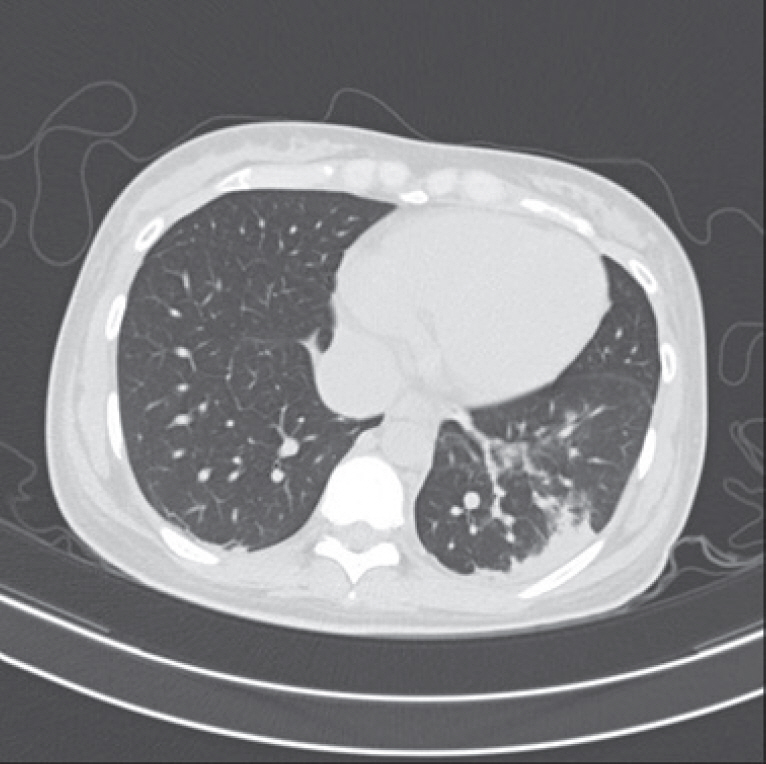Obstet Gynecol Sci.
2020 Nov;63(6):745-749. 10.5468/ogs.20106.
A case of delivery of a pregnant woman with COVID-19 infection in Daegu, Korea
- Affiliations
-
- 1Department of Obstetrics and Gynecology, Keimyung University School of Medicine, Daegu, Korea
- 2Department of Obstetrics and Gynecology, Fatima Hospital, Daegu, Korea
- 3Department of Obstetrics and Gynecology, Graduate School of Medicine, Kyungpook National University, Daegu, Korea
- 4Department of Obstetrics and Gynecology, Catholic University of Daegu School of Medicine, Daegu, Korea
- KMID: 2511216
- DOI: http://doi.org/10.5468/ogs.20106
Abstract
- Coronavirus disease 2019 (COVID-19) is caused by severe acute respiratory syndrome coronavirus 2 (SARS-CoV-2), which is affiliated with the β-coronavirus subgroup, which includes SARS-CoV and Middle East respiratory syndrome coronavirus (MERS-CoV), but is far more infectious than the 2. Because it is potentially life-threatening to infants and pregnant women with weak immune systems, clinical manifestations and vertical transmission of COVID-19 are matters of interest. Staff of the obstetrics department of university hospitals in Daegu and of the Daegu metropolitan government designated Daegu Fatima Hospital for the delivery of pregnant women with suspected and confirmed SARS-CoV-2 infection. Thirteen pregnant women with laboratory-confirmed COVID-19 were identified. Among them was a 28-year-old pregnant woman who had recovered from COVID-19 and had given birth to a healthy girl at 38 weeks of gestational age. We present our uncommon experience with a brief review of literatures.
Keyword
Figure
Cited by 2 articles
-
Maternal Outcomes and Clinical Characteristics of COVID-19 in Korean Pregnant Women during the Early Period of the Pandemic
Youseung Chung, Dong-Hwan Choi, John G. Ilagan, Juneyoung Lee, Young Kyung Yoon
J Korean Med Sci. 2021;36(41):e290. doi: 10.3346/jkms.2021.36.e290.COVID-19 and vaccination during pregnancy: a systematic analysis using Korea National Health Insurance claims data
Ki Hoon Ahn, Hae-In Kim, Kwang-Sig Lee, Ju Sun Heo, Ho-Yeon Kim, Geum-Joon Cho, Soon-Cheol Hong, Min-Jeong Oh, Hae-Joong Kim
Obstet Gynecol Sci. 2022;65(6):487-501. doi: 10.5468/ogs.22060.
Reference
-
References
1. Cui J, Li F, Shi ZL. Origin and evolution of pathogenic coronaviruses. Nat Rev Microbiol. 2019; 17:181–92.
Article2. Lu R, Zhao X, Li J, Niu P, Yang B, Wu H, et al. Genomic characterisation and epidemiology of 2019 novel coronavirus: implications for virus origins and receptor binding. Lancet. 2020; 395:565–74.3. Schwartz DA, Graham AL. Potential maternal and infant outcomes from (Wuhan) coronavirus 2019-nCoV infecting pregnant women: lessons from SARS, MERS, and other human coronavirus infections. Viruses. 2020; 12:194.4. Huang C, Wang Y, Li X, Ren L, Zhao J, Hu Y, et al. Clinical features of patients infected with 2019 novel coronavirus in Wuhan, China. Lancet. 2020; 395:497–506.
Article5. Wang D, Hu B, Hu C, Zhu F, Liu X, Zhang J, et al. Clinical characteristics of 138 hospitalized patients with 2019 novel coronavirus-infected pneumonia in Wuhan, China. JAMA. 2020; 323:1061–9.
Article6. Madinger NE, Greenspoon JS, Ellrodt AG. Pneumonia during pregnancy: Has modern technology improved maternal and fetal outcome? Am J Obstet Gynecol. 1989; 161:657–62.
Article7. Holshue ML, DeBolt C, Lindquist S, Lofy KH, Wiesman J, Bruce H, et al. First case of 2019 novel coronavirus in the United States. N Engl J Med. 2020; 382:929–36.
Article8. Chen H, Guo J, Wang C, Luo F, Yu X, Zhang W, et al. Clinical characteristics and intrauterine vertical transmission potential of COVID-19 infection in nine pregnant women: a retrospective review of medical records. Lancet. 2020; 395:809–15.
Article9. Zhu H, Wang L, Fang C, Peng S, Zhang L, Chang G, et al. Clinical analysis of 10 neonates born to mothers with 2019-nCoV pneumonia. Transl Pediatr. 2020; 9:51–60.
Article10. Ng WF, Wong SF, Lam A, Mak YF, Yao H, Lee KC, et al. The placentas of patients with severe acute respiratory syndrome: a pathophysiological evaluation. Pathology. 2006; 38:210–8.
Article11. Rasmussen SA, Smulian JC, Lednicky JA, Wen TS, Jamieson DJ. Coronavirus Disease 2019 (COVID-19) and pregnancy: what obstetricians need to know. Am J Obstet Gynecol. 2020; 222:415–26.
Article12. Chen D, Yang H, Cao Y, Cheng W, Duan T, Fan C, et al. Expert consensus for managing pregnant women and neonates born to mothers with suspected or confirmed novel coronavirus (COVID-19) infection. Int J Gynaecol Obstet. 2020; 149:130–6.13. Arabi YM, Mandourah Y, Al-Hameed F, Sindi AA, Almekhlafi GA, Hussein MA, et al. Corticosteroid therapy for critically ill patients with Middle East respiratory syndrome. Am J Respir Crit Care Med. 2018; 197:757–67.
Article14. Poon LC, Yang H, Lee JC, Copel JA, Leung TY, Zhang Y, et al. ISUOG Interim Guidance on 2019 novel coronavirus infection during pregnancy and puerperium: information for healthcare professionals. Ultrasound Obstet Gynecol. 2020; 55:700–8.15. Mullins E, Evans D, Viner RM, O’Brien P, Morris E. Coronavirus in pregnancy and delivery: rapid review. Ultrasound Obstet Gynecol. 2020; 55:586–92.
Article
- Full Text Links
- Actions
-
Cited
- CITED
-
- Close
- Share
- Similar articles
-
- Coronavirus Disease 2019 Vaccines and Pregnancy: Present and Future
- Recent Trend about Pregnant Women with Suspected or Confirmed Coronavirus Disease 2019 (COVID-19) Infection
- Factors influencing maternal-fetal attachment in pregnant women during the COVID-19 pandemic: a cross-sectional study
- Infection control of operating room and anesthesia for cesarean section during the COVID-19 outbreak in Daegu, the Republic of Korea -a case series-
- Maternal Outcomes and Clinical Characteristics of COVID-19 in Korean Pregnant Women during the Early Period of the Pandemic



